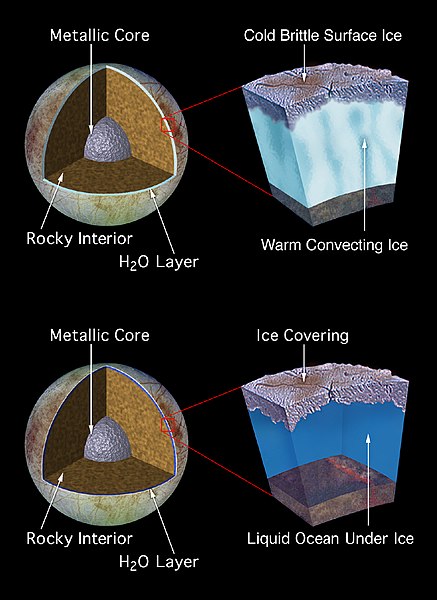Fasciculus:EuropaInterior1.jpg

Mensura huius perspectionis: 437 × 600 elementa imaginalia. Aliae mensurae: 175 × 240 elementa imaginalia | 350 × 480 elementa imaginalia | 559 × 768 elementa imaginalia | 1 192 × 1 636 elementa imaginalia.
Sua resolutio (1 192 × 1 636 elementa imaginalia, magnitudo fasciculi: 696 chiliocteti, typus MIME: image/jpeg)
Historia fasciculi
Presso die vel tempore fasciculum videbis, sicut tunc temporis apparuit.
| Dies/Tempus | Minutio | Dimensiones | Usor | Sententia | |
|---|---|---|---|---|---|
| recentissima | 19:23, 7 Februarii 2019 |  | 1 192 × 1 636 (696 chiliocteti) | Kesäperuna | 100% JPEG quality from full quality TIFF. |
| 02:13, 15 Decembris 2007 |  | 1 192 × 1 636 (170 chiliocteti) | Mu301 | {{Information |Description={{en|Model of Europa's subsurface structure.<br/> ==== Original caption released with image ==== These artist's drawings depict two proposed models of the subsurface structure of the Jovian moon, Europa. Geologic | |
| 01:47, 15 Decembris 2007 |  | 1 192 × 1 636 (170 chiliocteti) | Mu301 | == Summary == {{Information | Description = Model of Europa's subsurface structure. | Source = NASA's [http://photojournal.jpl.nasa.gov/index.html Planetary Photojournal], PIA01669: * Source URL: http://photojournal.jpl.nasa.gov/jpe |
Nexus ad fasciculum
Ad hunc fasciculum nectit:
Usus fasciculi per inceptus Vicimediorum
Quae incepta Vici fasciculo utuntur:
- Usus in ar.wikipedia.org
- Usus in azb.wikipedia.org
- Usus in beta.wikiversity.org
- Usus in bg.wikipedia.org
- Usus in en.wikipedia.org
- Usus in en.wikibooks.org
- Usus in en.wikiversity.org
- Usus in es.wikipedia.org
- Usus in fa.wikipedia.org
- Usus in fr.wikipedia.org
- Usus in hi.wikipedia.org
- Usus in is.wikipedia.org
- Usus in ja.wikipedia.org
- Usus in kk.wikipedia.org
- Usus in ko.wikipedia.org
- Usus in nn.wikipedia.org
- Usus in no.wikipedia.org
- Usus in pnb.wikipedia.org
- Usus in ro.wikipedia.org
- Usus in sl.wikipedia.org
- Usus in tr.wikipedia.org
- Usus in ur.wikipedia.org
- Usus in vi.wikipedia.org
- Usus in zh.wikipedia.org


